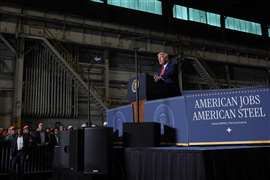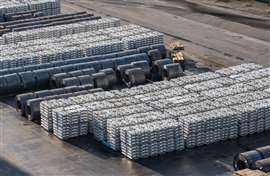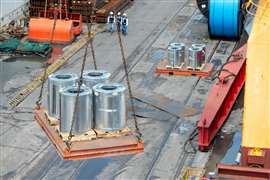Read this article in French German Italian Portuguese Spanish
Trump tariffs: How hike on steel and aluminium could inflate building costs 7-8%
06 June 2025
 US President Donald Trump delivers remarks at U.S. Steel Corporation–Irvin Works in West Mifflin, Pennsylvania, US, on 30 May 2025. Image: Reuters/Leah Millis
US President Donald Trump delivers remarks at U.S. Steel Corporation–Irvin Works in West Mifflin, Pennsylvania, US, on 30 May 2025. Image: Reuters/Leah Millis
Despite a 90-day suspension of a raft of tariffs on countries around the world, imposed by US President Donald Trump, the tariff challenge for the construction industry hasn’t gone away.
In fact, while some tariffs have been suspended and the practice of levying them on multiple nations all at once has resulted in a legal challenge, Trump has introduced other tariffs on steel and aluminium (see timeline below).
Those 50% steel and aluminium tariffs, announced at the end of May, came into force last week (4 June).
And one contractor, Skanska USA Building, has outlined the tens of millions of dollars they are likely to add to the cost of a typical project.
 Sarah Vakili, Skanska USA
Sarah Vakili, Skanska USA
In a recent webinar hosted by the company, Sarah Vakili, senior director of business planning and strategy at Skanska USA Building, modelled a hypothetical US$375 million healthcare project to show the impact of the tariffs.
“If there is a 50% steel and aluminium tariff on all importing countries, plus a 10% reciprocal tariff on all imports and a Chinese tariff of 30%, we estimate an $18 to $22 million increase [on the hypothetical project],” Vakili said.
That equals a 7–8% hike, up from a March estimate of 4–5%.
She added that “about half” of the increase would come from derivative products, such as window systems or fixtures with steel or aluminium parts. These items may not be taxed as raw materials, but tariffs can still apply to their metal content under Section 232 of the US Trade Expansion Act.
Slowing activity but improved bidding climate
Towards the end of last month, the Associated General Contractors of America (AGC) blamed worries about recently announced tariffs and future tax rates for employers for holding back employment gains in some regions of the US.
Vakili also pointed to broader economic signs of slowing construction activity.
“Indicators like the AIA Billing Index and input from economists suggest reduced growth in construction starts and spending,” she said. “Interest rates remain elevated, and federal policies are creating a cautious outlook.”
Even so, she noted signs of pricing stabilisation.
“We’ve actually been reporting an improved bidding climate compared to the past three years,” she said, citing greater subcontractor availability amid slowing project starts.
Vakili outlined additional ways to manage volatility:
- Review and revise specifications or contract terms, especially around escalation and force majeure
- Add tariff contingencies where risk is high
- Avoid pushing all cost risk onto trade partners
- Use indexed or unit-based pricing in lieu of fixed bids
- Stay flexible as conditions change
“This is fluid… things are changing every day,” she said.
Rethinking the supply chain amid Trump-era tariffs
As tariff policies tighten, US construction suppliers are forced to rethink sourcing, pricing, and project coordination daily.
Chris Gregory, executive vice president at structural steel fabricator SteelFab, said the biggest pressure is on coil-based steel products such as hollow structural sections (HHS), plates, and bar grating (structural steel product made from parallel steel bars joined by crossbars at right angles).
 Ingots of aluminum and rolls of steel stored at a quayside. (Image: Adobe Stock)
Ingots of aluminum and rolls of steel stored at a quayside. (Image: Adobe Stock)
“Six of the top imported steel products are coil or plate types,” he said. “There’s a lot more import activity in those than in wide flange [steel beam] sections.”
SteelFab, which runs 15 US plants and processes more 200,000 tons of steel annually, sources nearly all of its material domestically. But domestic pressure has grown: coil prices rose 22% earlier in the year, HSS jumped 50%, and even wide flange steel beams ticked up 8%. A short-term dip in coil quickly reversed after the latest tariff announcements.
“Demand at the mills and this recent news could probably see [prices] tick up a little bit more,” Gregory said.
Meanwhile Sarah Andreasen, North American sales for Kawneer, an aluminium products supplier, said that the company has started rerouting some cross-border transactions with billet (semi-finished metal bar) suppliers to avoid tariff triggers, and its North American production footprint offers room to pivot.
Responding to Construction Briefing on whether the current economic conditions are impacting demand, both executives noted that a softening, especially in the private sector. Andreasen described a quieter-than-usual spring in the façade market, while Gregory said regional disparities persist.
“The East Coast seems slammed with large projects,” he said. “But our West Coast counterparts don’t have as flush of a backlog.”
Gregory also noted a shift in projects to the Great Lakes Region and Rust Belt, which includes (among others) the states of Pennsylvania, Ohio, Indiana, Michigan, Illinois, and Wisconsin, where power and permitting are more accessible compared to major US coastal cities.
 Galvanised steel coils are moved at a shipping yard. (Image: Adobe Stock)
Galvanised steel coils are moved at a shipping yard. (Image: Adobe Stock)
To reduce tariff exposure and secure better pricing, both suppliers emphasised early coordination with contractors. Gregory described a recent example where SteelFab bundled demand from multiple projects into a single 15,000-ton order. By committing to a large volume upfront with one mill, they locked in lower pricing and more favourable terms than they could have through fragmented, project-by-project bids.
“That gave us price certainty, better terms, and saved a tremendous amount of money,” he told the Briefing.
Andreasen added early involvement with design teams can also reduce risk by allowing for material substitutions or system tweaks before specs are finalised.
“There’s a lot of opportunity to meet design intent while mitigating impacts,” she said, particularly by avoiding tariffed components or selecting materials with steadier domestic supply.
Construction must coordinate in chaos
The current US tariff policy may be unpredictable, but the effects on steel and aluminium costs are real and immediate.
Contractors and suppliers can’t control trade policy, but they can influence outcomes through early coordination, bundled orders, flexible specifications, and open lines of communication.
In a shifting market, coordination is one of the few tools contractors can still control.
Trump tariff timeline
Robert Cantando, national director of strategic supply chain at Skanska USA Building, shared a timeline of key trade and legal developments shaping construction material pricing in mid-2025:
- Tariffs suspended, then reimposed: On 9 April, the US paused reciprocal tariffs of up to 84% on Chinese goods and 25–45% on others, replacing them with a 10% base tariff across all imports.
- US–China reset: In May, the US and China agreed to a 90-day cooling period, reducing respective tariffs to 10% (US) and 30% (China) from peaks of 145% and 125%.
- IEEPA legal challenge and reversal: A US court ruled that certain tariffs enacted under the International Emergency Economic Powers Act were improperly applied—only for a federal appeals court to temporarily stay the decision the following day.
- Steel and aluminium tariff doubling: On 30 May, the US announced import tariffs on steel and aluminium would double to 50%, effective 4 June.
Cantando said the Midwest Premium for aluminium jumped 54% after the May announcement, and hot roll coil pricing rose $50 per ton in three days.
 Robert Cantando, Skanska USA
Robert Cantando, Skanska USA
“These announcements sent shock waves across global markets,” he said. “Stock markets plummeted, and commodity futures trading dove in anticipation of a global recession.”
The shift has disrupted contractor confidence, Cantando said, replacing a sense of stability with uneasiness.
“Manufacturers and suppliers are taking action to remain competitive,” he said. “Many are shifting sourcing and materials to minimise the impact of tariffs.”
STAY CONNECTED



Receive the information you need when you need it through our world-leading magazines, newsletters and daily briefings.
CONNECT WITH THE TEAM









